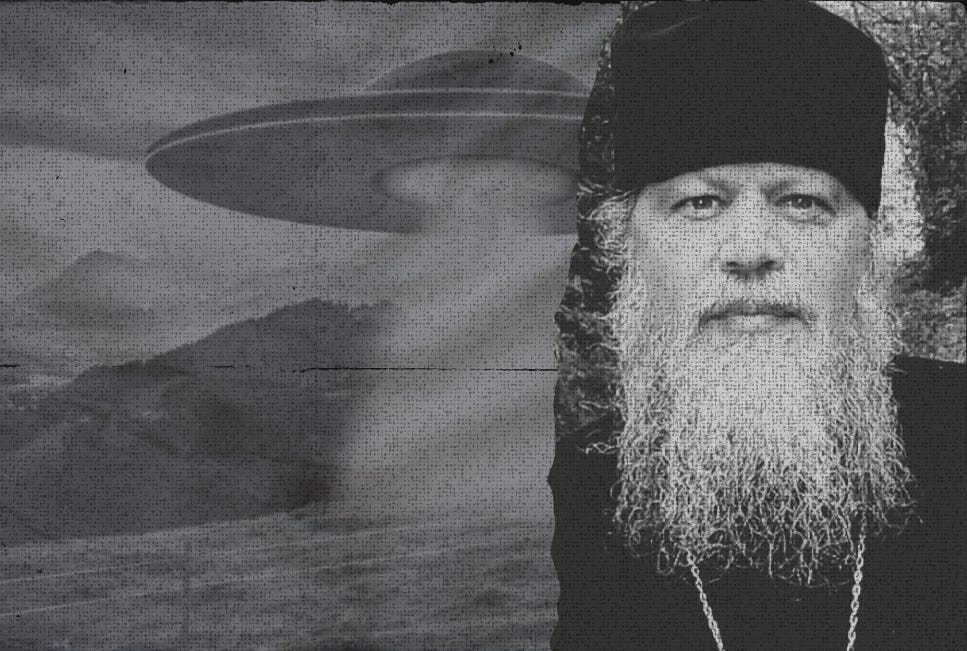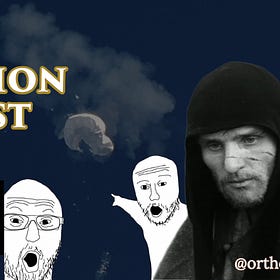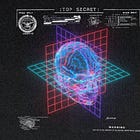This book sat on my shelf for 2 years and I never read a single page. My reasoning, although completely unfounded, was that nothing more needed to be said about the UFO phenomenon that hasn’t already been addressed by Fr. Seraphim Rose in his book Orthodoxy and the Religion of the Future. Aliens are demons, got it. UFOs are the materialized vessels they travel in, got it. Don’t be decieved by activity in the sky; you get the idea.
Recently, mainstream discourse of UFOs once again came to the forefront with US residents all across the east coast reporting mysterious drones and orbs in their backyard (myself included). This has been going on for months and there is still no official explanation, not even an attempt at one. My friends and family kept coming to me for answers and I would dismiss it with something like “I don’t know what they but the more you obsess over it, the more likely you will be decieved”. That is partly true and it’s the general sentiment I shared in my podcast episode on the UFO phenomena during the 2023 “Chinese spy balloon” incident".
UFO's and the New Religious Consciousness
In this episode, I discuss the spiritual implications of the UFO and alien phenomenon and refer to the various warnings from elders and saints of the Church such as Fr. Seraphim Rose and St. Gabriel of Georgia.
I was not satisfied with my response, neither were my friends and family. They didn’t express it, but I knew they were expecting more. Suddenly, Fr. Spyridon’s book started really sticking out on my shelf. If I wasn’t going to be compelled to read it now, I never will.
As it came time to craft this year’s reading list for the book club, I added it to the list for January as a timely and sobering reminder that literally overnight, this UFO deception could become so widespread that it could become something we have to deal with in our every day life. There will be a time when simply going outside at night would never be the same.
Fr. Spyridon starts his book sharing the story of his wife’s encounter with a UFO on New Years Eve, 1978. In the first few chapters, he sets the stage by examining the characteristics, effects and dangers of the UFO phenonemon to present it as real and not some mass delusion. He starts with the first reported UFO sightings in 1933, described as “ghost ships” over London, seen in “extremely trecherous conditions” (p.14).
Many of the reports documented involve the U.S. government response (or lack thereof) to military reports of sightings by various pilots and high ranking officials. Sightings reached a peak by 1952 and by 1953, there were so many reports that it became a criminal activity with up to 10 years in prison for any military personell who discussed reports of UFOs. By the late 1980s, military psyops began associating the UFO phenomenon with conspiracy theories to control public discourse.
It wasn’t until 2020 when the unclassified Unidentified Aerial Phenomena Task Force (UAPTF) program confirmed that there were in fact secret ongoing efforts funded by the US government to examine UFO reports, dating back to 2007. Reports of sightings have continued to spike and lull through the years, but they have certainly not ceased. All that has changed as we enter 2025, is that we are now well beyond the UFO phenomenon belonging to the realm of conspiracy.
The most glaring problem with secular UFO research, as Fr. Spyridon points out, is in its purely materialistic approach. He revisits August 21, 1924, when the National Radio Silence Day marked humanity's first coordinated attempt to detect extraterrestrial transmissions. This materialistic worldview would later be championed by figures like Steven Spielberg and Carl Sagan, whose contributions to the SETI Institute helped shape public perception of extraterrestrial life.
Sagan's atheistic worldview demonstrates how his extreme interpretation of the Copernicus Principle reduced Earth to just another "Pale Blue Dot" - an insignificant speck in the vast, ever-expanding universe. This view is ironically similar to the polytheistic cosmology of Ptolemaic Egypt and aligns perfectly with the UN's globalist agenda of dissolving national and cultural identities. Coincidentally, there is a sci-fi theme here that was not mentioned by Fr. Spyridon, but it relates to the Stargate series which involves the opening of an alien portal to ancient Egypt.
Fr. Spyridon focuses on the contrasts between modern cosmology and Biblical teachings of the cosmos. He warns that mankind risks its salvation by gambling on ever-changing scientific theories about the cosmos, pointing to how even the "Goldilocks Zone" theory of Earth's perfect conditions for life reveals the extraordinary nature of Earth’s creation rather than random chance.
I found the NASA chapter particularly interesting about the first photograph of Earth from space - the famous "Blue Marble" from 1968. Fr. Spyridon shares the profound spiritual impact this image had on the astronauts: Bill Anders abandoned his Catholic faith, while Frank Borman and Jim Lovell became more convinced of a greater reality beyond the physical universe.
One of the most compelling chapters deals with the aerial realm and covers Jacques Vallee's interdimensional hypothesis (1963), which attempted to bridge the gap between scientific and paranormal explanations. While Vallee's work as a consultant for Project Stargate (the U.S. Army's remote viewing program) lent credibility to his theories, Fr. Spyridon exposes how his interpretation actually serves to undermine traditional Christian beliefs by reinterpreting Biblical stories like ascribing Ezekiel's vision to UFO encounters.
The book takes a particularly dark turn when examining the relationship between UFO encounters and occult practices. Fr. Spyridon cites John Keil's research showing UFO manifestations coinciding with bloodshed in war, and discusses the troubling statistic that 63% of ritual abuse victims are college-educated women involved in New Age practices.
I found the most fascinating chapter to be Fr. Spyridon's analysis of science fiction's role in shaping public consciousness, which is especially relevant today. Fr. Seraphim Rose shares a similar commentary in Orthodoxy and the Religion of the Future, but he does not detail particular films or novels like Fr. Spyridon does, so it offered a refreshing modern context.
From Kepler's first science fiction story about a journey to the moon to modern CGI-enhanced blockbusters, he traces how these narratives have gradually replaced traditional religious worldviews with a "post-Christian" philosophy, a concept Fr. Seraphim also mentions. His examination of Spielberg's "Close Encounters of the Third Kind," with its messianic "chosen people" narrative and hidden occult symbolism (including the famous tritone chord suggesting "Yahweh"), reveals how deeply these these esoteric themes manipulated public consciousness.
The book concludes with a powerful reminder from Fr. Seraphim Rose about the mediumistic nature of UFOs, echoing St. Ignatius Brianchaninov's warning that our ability to experience true miracles diminishes as our thirst for signs and wonders grows. In our current age of increasing UFO sightings and government disclosures, Fr. Spyridon's book is crucial for an Orthodox Christian perspective on a phenomenon that can no longer be ignored or dismissed as mere conspiracy theory.
This thorough examination of the UFO phenomenon through an Orthodox lens couldn't be more timely. As we witness the gradual normalization of UFO encounters in mainstream discourse and aerial phenomenon in our own backyards, Fr. Spyridon's work provides essential spiritual context and warnings for Orthodox Christians navigating these increasingly strange times.
As we read The UFO Deception, I look forward to hearing your insights, experiences and commentary in the replies below and in our Discord community.
Member Review
One of our book club members Smeagol kicked off his newly launched Substack with a review of his own. I’d love to see more of this. Part of the value of the book club is those who participate are developing their reading and thinking skills. Writing is the most effective way to get the most out of your reading. So as you write your commnents and reviews, you will be generating content that you can use for your own publication. If you do the same as our friend “Smeagol” here, please share it and I would love to promote your work accordingly.
Weekly Discord Discussions
Thursday, February 9th (Chapters 1-6)






There appears to be a conflict between the impulse to search and explore for life outside of our planet and Christian dogma. I like how Father Spyridon addressed it by focusing on the intention. I would hope that searching and exploring would be ok. But he pointed out that after resounding failures, the SETI types never pivoted their hypothesis and thus revealed their intentions: to validate an atheist worldview.
How would/could an Orthodox Christian approach space exploration?
The most provocative message in the book is that this ET/UFO/aliens science that is being done, with millions upon millions spent, is not driven by human curiosity but a desperate need to validate an atheist worldview.
(Just was listening to a discussion on the book "the myth of disenchantment".... Similar ideas.)
When you begin to evaluate your unexamined views and beliefs, and prior utterances, you realize how drenched you are in modernism, secularism, and atheism.